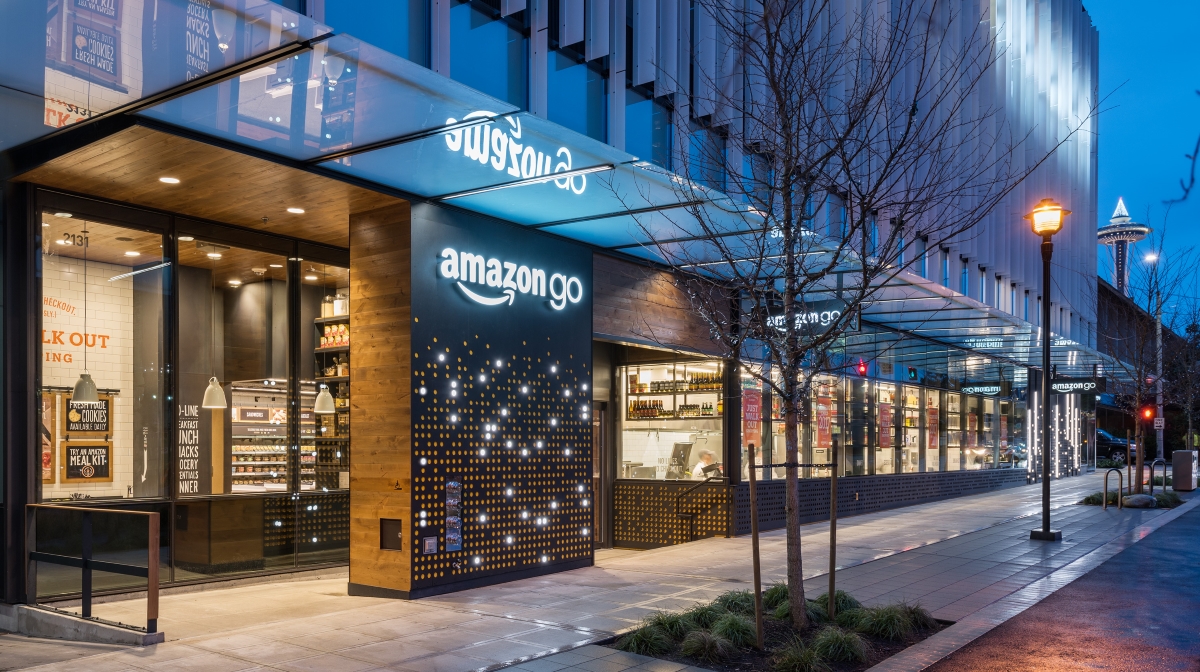Hitting the High Street: Amazon’s moves into physical retail
- Wednesday, September 13th, 2017
- Share this article:
 However you measure it, there is no way of denying that traditional retail brands find themselves in crisis. From major cities to suburban shopping centres, branches are being emptied and shuttered, with several notable brands having declared bankruptcy, liquidation or major cutbacks in the past two years.
However you measure it, there is no way of denying that traditional retail brands find themselves in crisis. From major cities to suburban shopping centres, branches are being emptied and shuttered, with several notable brands having declared bankruptcy, liquidation or major cutbacks in the past two years.
Department stores like J.C. Penney, Macy’s and Sears have announced more than 100 closures within the past 12 months, while a number of clothing brands, including American Eagle, Lululemon and Urban Outfitters, have seen stocks tumble to multi-year lows this year. Some pessimistic analysts have said that 2017 could mark a tipping point, and are betting heavily on malls and large retailers closing down in record numbers. So why is Amazon choosing this moment to leave the pure-play digital realm and enter the world of physical stores?
Before we try to pick apart the decision-making of Bezos and co, however, it’s important to gain an understanding of retail’s current woes. With the economy having finally shaken off the effects of the 2007 financial crash, these closures aren’t the result of economic forces. So what is causing them?
The growth of eCommerce is a huge factor here, obviously. Despite the majority of purchases still taking place in physical stores, online retail growth outstrips physical retail by a huge margin. Between 2010 and 2016, Amazon’s sales in North America more than quintupled, growing from $16bn (£12bn) to $80bn. Perhaps more impressively, there are now over 80m Amazon Prime subscribers in the US, accounting for around a quarter of the total population, and each spending an average of around $1,300 on the eCommerce platform every year.
eCommerce isn’t just growing though – it’s also evolving. When the first online retailers were on the rise, it was media and entertainment that were the big sellers: DVDs, books, music and games. But over time, consumers have become more used to purchasing products over the internet. Along with improved delivery times and a focus on making online purchases as smooth and risk-free as possible, this has led to dramatic increases in apparel sales – traditionally the domain of high-street stores – which now make up the largest category of online purchases.
Shoppers researching items online prior to purchase has driven down prices and eliminated impulse buys and incidental sales. The rise of the smartphone has not only enabled trends like ‘showrooming’ but also put every store in the pocket of the consumer, right next to their credit card – or in some cases, even integrated them together. Apps and mobile wallets have made the previously painful experience of shopping on mobile sites into a relatively simple transaction, and as a result, mCommerce has increased from two per cent of online spending in 2010 to 20 per cent this year.
Bricking It
There are other cultural and economic factors at play too, especially in the US. The shopping mall, once the symbol of American retail power, is in sharp decline. A report into the state of retail by research analysts Cowen & Company found that while the effects of the recession may be coming to an end, they may have already done enough damage to kill off the mall.
Stagnating wages and a focus on essentials saw consumer spending drop, especially for the premium brands and department stores that often formed the backbone for shopping malls. As those brands saw sales slow and shut down ‘anchor branches’, it resulted in a snowball effect that saw other smaller stores unable to capitalise on consumers drawn to locations by big names. Mall visits dropped by 50 per cent between 2010 and 2013, and have continued to fall every year since.
Spending habits are also shifting. Since the financial crash, there has been a profound change in how consumers choose to spend their disposable income. Travel, dining out and entertainment have become the new hot sectors as consumers focus more on experiences than material goods. Spending on clothes, traditionally a strong measure of economic health, has seen its share of total consumer spending decline by 20 per cent over the last 15 years, but hotel occupancy and airline tickets are soaring.
Sales in food and drink services have grown twice as fast as all other retail spending categories since 2005, and in 2016 Americans spent more money in restaurants and bars than they did at grocery stores. As millennials make up a growing portion of consumers, analysts have even pointed towards social media as a factor in this shift, with a visit to a restaurant or a trip abroad much more likely to result in likes on Instagram than a new pair of shoes.
“Retail square feet per capita in the US is more than six times that of Europe or Japan,” said Richard Hayne, CEO of Urban Outfitters during a conference call with industry analysts. “And this doesn’t count digital commerce. Our industry, not unlike the housing industry, saw too much square footage capacity added in the 1990s and early 2000s. Thousands of new doors opened and rents soared. This created a bubble, and, like housing, that bubble has now burst. We are seeing the results: doors shuttering and rents retreating. This trend will continue for the foreseeable future, and may even accelerate.”
So with all this bad news for physical retail brands, why is Amazon still seeking to establish a foothold in the world of bricks-and-mortar branches?
A foot in the revolving door
A crucial factor in Amazon’s move into the world of storefronts and shop floors is where it is focusing its efforts. While the company has experimented with a few pop-up bookstores in a variety of locations and a single permanent branch in Columbus Circle in New York City (with the promise of around a dozen more to open soon), the brunt of its bricks-and-mortar efforts seem tightly aimed at the grocery market.
This is a different vertical to the one Amazon has traditionally competed in, and one with plenty of space to grow – in the US, the grocery market is estimated to be worth $800bn. While supermarkets in the UK have embraced home delivery services, the US has lagged behind somewhat, held back partly by the sheer size of the country, as well as the complex logistics required to deliver fresh food on demand. To do so requires a large established delivery infrastructure that many smaller grocery brands are simply unwilling to invest in. Amazon, on the other hand, already has its built.
That’s home delivery, though – it doesn’t answer the question of why Amazon feels the need to establish physical stores. The truth is that Amazon needs to establish a reputation as a grocery retailer before people are willing to trust online ordering, and that means bricks-and-mortar stores.
Amazon has been attempting to break into the grocery market for almost a decade now, having started with small-scale experiments and built up to Amazon Fresh, the company’s current grocery delivery business. But even with its extensive logistics network, the firm has struggled to get people on board. In the UK, where the online grocery market is expected to double in value between 2015 and 2020 to £17.2bn, Amazon Fresh was only able to achieve a 0.7 per cent market share after six months of operation. In the US, where the service has been running for eight years, it still only accounts for less than one per cent of grocery spending, and only operates in six cities, well behind its original projection of 50.
“Online grocery is failing,” says Dr Kurt Jetta, CEO and founder of TABS Analytics, a consumer products research firm. “There’s just not a lot of demand there. The whole premise is that you’re saving people a trip to the store, but people actually like going to the store to buy groceries.”
John Gillan, managing director for UK and Northern Europe at Criteo, agrees: “Nearly 90 per cent of sales are still done in store. We are obviously seeing more and more sales where people are, for example, using ‘click and collect’ – that’s huge here in the UK, so people are doing more research online, then going to stores and picking up their items there.
“Amazon are obviously looking to move into physical retail. In the past we’ve seen other players like Warby Parker in the US, they’re an online player and launched stores, and were incredibly successful at it. I think you’re seeing more and more of these pure players recognising that they need to have a physical presence because people still like that social experience of going to stores.”
Amazon seems to have finally grasped that lesson, and is now taking a different approach. Take a look at most of the company’s innovations from the past few years, and all of them seem designed to acclimatise people to the idea of using Amazon for everyday grocery and FMCG purchases.
Supermarket swoop
The Dash buttons are an obvious case, but even the popular Amazon Echo is an avenue for this market. The idea of people using its voice command function for expensive purchases that require research feels unlikely. But a quick way of reordering toilet paper or tomorrow’s dinner? Given most consumers’ preference for ease and convenience, that could easily become a reality.
The company’s acquisition of Whole Foods, then, is the next big step in this plan. The brand is popular with the kind of young middle-class professionals who are likely to be both Amazon Prime subscribers and early adopters of new technology. Plus, by acquiring an existing firm with a strong brand identity, Amazon can sidestep the risk of consumers being reluctant to buy their fresh fruit and steaks from a name they associate with cheap DVDs and books.
The Whole Foods acquisition has been hailed as potentially revolutionary by industry analysts. Jonathon Jacobson, founder of Highfields Capital Management, called the acquisition “true genius” and predicted that Amazon will “slash its profitability for the foreseeable future in order to grow market share”. This move could be disastrous for other grocery brands who cannot compete with Amazon’s scale and financial clout.
The acquisition also has the support of consumers. A study by market research firm GfK shows that a quarter of US shoppers approve of the merger, while only 10 per cent disapprove. The research also shows that among Whole Foods shoppers, 38 per cent believe the acquisition will have positive effects. In the case of consumers who have made purchases from both firms in the past month, 43 per cent are looking forward to the merger, predicting that it will drive down prices and include free delivery for Prime members, while also hoping that Whole Foods’ quality won’t be impacted.
While 78.5 per cent of US consumers avoid Whole Foods because prices are too steep, Amazon has a great reputation among shoppers, and the decrease in prices predicted by Jacobson and others is expected to have a considerable impact if it materialises.
“Amazon has a better price perception than Walmart these days, which is amazing,” says Wendy Wallner, executive vice president of consulting for the retail industry at GfK and co-author of the study. “[Consumers] hope that that gets taken care of at Whole Foods.”
A retail Cold War
Amazon’s attempts to enter the real world of groceries aren’t going unchallenged, however. Traditional retailers who still dominate this space are fighting back, with a growing focus on online ordering, home delivery and click-and-collect, bringing the advantages that eCommerce offers to brands that consumers are more familiar with when it comes to the weekly shop.
“Grocers that are customer-centric are going to win,” says Shannon Warner, vice president of North American retail for Capgemini Consulting.
According to Warner, succeeding will require “leveraging all of the data they have about the customer to personalise experiences and make them more relevant”. For Walmart, that has meant a massive investment in infrastructure. The retail giant has seen a 63 per cent growth in US eCommerce sales in the first quarter of 2017, thanks to incentives like free two-day shipping with no membership fees, and discounts for customers who pick up in store. The company is opening new fulfillment centres across the US to keep up with demand, and has introduced a new feature for its mobile app that combines both in-store and online purchases for easy reordering.
The fight to innovate hasn’t just resulted in improvement though – it’s also led to an increasingly fractious Cold War with Amazon. After news of the Whole Foods deal broke, the Wall Street Journal reported that Walmart was among a number of large retailers that were asking vendors to abandon Amazon Web Services (AWS) in favour of alternative providers such as Microsoft Azure, which Walmart uses.
Walmart has denied this, but acknowledged that its growing rivalry with Amazon meant that it had concerns about where and how its partners were storing their data and managing their digital business needs.
“Our vendors have the choice of using any cloud provider that meets their needs and their customers’ needs,” said a Walmart spokesperson in a statement. “It shouldn’t be a big surprise that there are cases in which we’d prefer our most sensitive data isn’t sitting on a competitor’s platform.”
Amazon hit back at the news, with a spokesperson calling Walmart’s strategy “bad for business and customers” and saying that many suppliers were “standing up to Walmart” and using AWS despite the retailer’s scare tactics.
“We’ve heard that Walmart continues to try to bully their suppliers into not using AWS because they have an incorrect view that AWS is somehow supporting Amazon’s retail business,” said the Amazon spokesperson. But while the relationship between Amazon’s retail and web services divisions isn’t exactly clear, there’s no ignoring that AWS is a money-spinner, bringing in $4.1bn in the most recent quarter.
A fresh perspective?
The Whole Foods deal has also drawn criticism from the United Food and Commercial Workers International Union (UFCW), which has filed a complaint with the Federal Trade Commission (FTC) and called for a thorough investigation of the proposed acquisition, a call which has been supported by a dozen members of Congress. The UFCW raised concerns for staff members at Whole Foods, claiming they faced an “uncertain future” due to the merger.
“Amazon’s acquisition of Whole Foods is not about improving customer service, products or choice,” said Marc Perrone, president of UFCW International. “It is about destroying Whole Foods jobs through Amazon-style automation. We strongly urge the FTC to carefully review this merger. We believe a fair and impartial analysis will prove that Amazon’s acquisition of Whole Foods is a competitive threat to our economy that will hurt workers and communities.”
The UFCW’s fears may be unfounded though. A study by the Progressive Policy Institute in March 2017 found that the automation and efficiencies driven by Amazon and other digital firms actually added jobs much faster than the general retail sector is losing them, and that digital sector jobs for production and non-supervisory workers are actually higher paid, with wages growing faster than in traditional retail. Even fears of clustered job distribution weren’t realised, with jobs and rising wages distributed across the entire US.
If Amazon’s move into the real world is good news for consumers, workers and the company’s future, the only ones left to lose out are traditional retailers who fail to keep up. Once the Whole Foods deal goes through, Amazon will still be an upstart player with a relatively small presence in the grocery market, but there’s a reason giants like Walmart and Target are worried.
The grocery business has largely avoided the disruptive effects of the digital revolution so far. If Amazon has its way, that’s about to end.
“Innovation at grocery stores is happening at a snail’s pace,” says Allen Adamson, founder of Brand Simple Consulting. “As more companies compete for customers in both the physical retail and eCommerce space, the winners will be those who can figure out how to live in both worlds.”

















